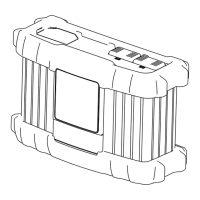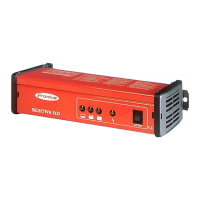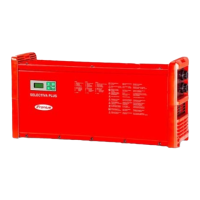8
*)
at the interface with the public grid
see "Technical data"
In this case, the plant operator or the person using the device should check whether the
device may be connected, where appropriate by discussing the matter with the power sup-
ply company.
IMPORTANT! Ensure that the mains connection is earthed properly
Dangers from
mains current
and charging cur-
rent
Anyone working with chargers exposes themselves to numerous dangers e.g.:
- Risk of electrocution from mains current and charging current
- Hazardous electromagnetic fields, which can risk the lives of those using cardiac
pacemakers
An electric shock can be fatal. Every electric shock is potentially life threatening. To avoid
electric shocks while using the charger:
- Do not touch any live parts inside or on the outside of the charger.
- Under no circumstances touch the battery poles
- Do not short-circuit the charging lead or charging terminals
All cables and leads must be secured, undamaged, insulated and adequately dimen-
sioned. Loose connections, scorched, damaged or inadequately dimensioned cables and
leads must be immediately repaired by authorised personnel.
Danger due to ac-
id, gases and va-
pours
Batteries contain acid which is harmful to the eyes and skin. During charging, gases and
vapours are released that may be harmful to health and are highly explosive in certain cir-
cumstances.
- Only use the charger in well-ventilated areas to prevent the accumulation of explosive
gases. Battery rooms are not deemed to be hazardous areas provided that a concen-
tration of hydrogen of less than 4% can be guaranteed by the use of natural or forced
ventilation.
- Maintain a distance of at least 0.5 m (19.69 in.) between the battery and charger dur-
ing the charging procedure. Possible sources of ignition such as fire and naked flames
must be kept away from the battery
- The battery connection (e.g. charging terminals) must not be disconnected for any
reason during charging
- Do not inhale any of the gases and vapours released under any circumstances
- Make sure the area is well ventilated
- To prevent short circuits, do not place any tools or conductive metals on the battery
- Battery acid must not get into the eyes or onto the skin or clothes. Wear protective
goggles and suitable protective clothing. Rinse any acid splashes thoroughly with
clean water and seek medical advice if necessary.
General informa-
tion regarding the
handling of bat-
teries
- Protect batteries from dirt and mechanical damage.
- Store charged batteries in a cool place. Self discharge is kept to a minimum at approx.
+2 °C (35.6 °F).
- Every week, perform a visual inspection to ensure that the acid (electrolyte) level in
the battery is at the Max. mark.
- If any of the following occur, do not start the device (or stop immediately if already in
use) and have the battery checked by an authorised workshop:
- uneven acid levels and/or high water consumption in individual cells caused by a
possible fault.
- overheating of the battery above 55 °C (131 °F).

